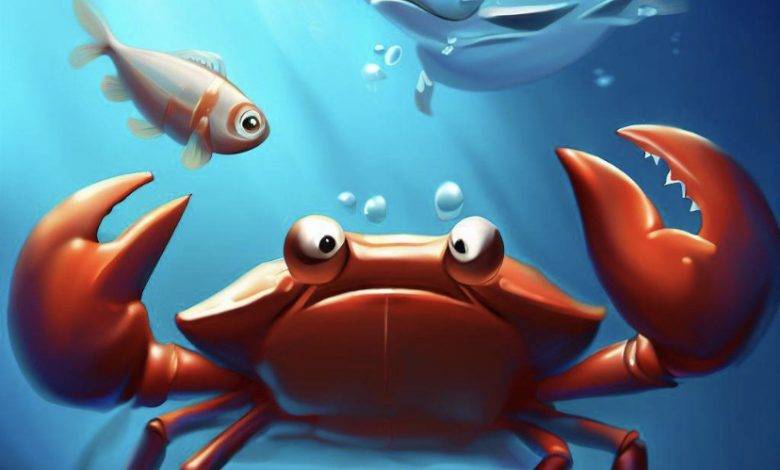Is a Crab a Fish?

Crabs and fish have always sparked our curiosity and delighted our taste buds. These amazing creatures of the underwater world have captivated our imaginations for ages. So, let’s take a plunge into the deep blue and uncover the secrets of crabs and fish!
So Is a Crab Considered a Fish?
the answer stands as No, a crab is not a fish. Although crabs and fish both call the water their home, they belong to separate taxonomic groups. Crabs are crustaceans, distant relatives of lobsters and shrimps, while fish belong to the vast world of vertebrates.
These evolutionary distinctions are what makes them so fascinating and different from each other. So, while they share the same watery realm, crabs and fish have their own place on the Tree of Life.
How Do Crabs and Fish Differ?
Crabs and fish may both reside in water, but their physical structures couldn’t be more distinct. Fish glide through the waves with their streamlined bodies, while crabs boast a tough exoskeleton and the ability to walk sideways.
Fish rely on scales, gills, and swim bladders for survival, while crabs sport intricate claws and appendages. These adaptations allow them to thrive in their respective environments. From the mesmerizing movements of fish to the peculiar sideways shuffle of crabs, their unique anatomical features make them true wonders of the sea.
Also Read: Are Fish Amphibians?
What Makes Crabs Unique?
Crabs possess a wide array of intriguing traits that set them apart from other creatures of the sea. Their exoskeleton, composed of chitin, acts as a protective armor while providing support for their bodies.
One of their remarkable abilities is limb regeneration, allowing them to regrow lost claws or legs. Crabs are also masters of disguise, blending seamlessly with their surroundings through camouflage. Their astonishing adaptability and unique characteristics make crabs a true marvel of nature.
Where Do Crabs Live? What About Fish? Comparing Habitats and Environments
Crabs and fish thrive in a variety of aquatic environments, each uniquely suited to their needs. Crabs can be found in coastal areas, estuaries, and even deep-sea trenches. Some species dig burrows in the sand, while others cling to rocky surfaces or hide among corals.
Fish, on the other hand, occupy a vast range of habitats, from freshwater rivers and lakes to the vastness of the open ocean.
Coral reefs teem with colorful fish, while rivers are home to species adapted to fast-flowing currents. Exploring their preferred habitats allows us to understand the diverse ecosystems in which these creatures reside.
Also Read: Are Fish Reptiles? Similarities and Differences
How do crabs reproduce and how do fish reproduce?
Crab Reproduction
Crabs reproduce through a process called sexual reproduction. Male crabs produce sperm, while female crabs have a pair of specialized structures called the gonopores, which serve as openings for reproductive organs.
During mating, the male crab transfers sperm into the female’s reproductive system through a specialized appendage called the gonopod. The female stores the sperm in a sac called the spermatheca until she is ready to fertilize her eggs.
Once the female crab is ready to lay eggs, she releases them into the water. The eggs are carried externally on the female’s abdomen, attached to specialized structures called pleopods.
These eggs are protected by a mass of gelatinous substance, forming a structure known as an egg mass or sponge. The female crab continues to carry the eggs until they hatch into larvae.
Fish Reproduction:
Fish exhibit various reproductive strategies, but the most common method is sexual reproduction. Most fish species have separate sexes, with males and females. However, some species are hermaphrodites, possessing both male and female reproductive organs.
In external fertilization, which is common in many fish species, the male fish releases sperm into the water, and the female fish releases her eggs. The eggs and sperm meet in the water, where fertilization occurs.
This method often involves large numbers of eggs and sperm to increase the chances of successful fertilization.
Internal fertilization is another method employed by certain fish species. In this case, the male fish transfers sperm into the female’s body using specialized organs, such as a modified fin or a structure called a gonopodium. The sperm fertilizes the eggs inside the female’s body before she releases them.
After fertilization, fish eggs may be scattered in the water or deposited in nests or burrows built by the parents. The incubation period varies depending on the fish species and environmental conditions.
Once the eggs hatch, fish larvae emerge and begin their independent life cycle.
It’s important to note that the reproductive processes of crabs and fish can vary among different species. The descriptions provided here are general representations of their reproductive strategies.
Do Crabs and Fish Eat?
Crabs and fish display a wide range of dietary preferences and feeding habits. Crabs are known for their scavenging tendencies, feeding on detritus, small organisms, and even carrion. Some species are opportunistic predators, ambushing prey that wanders too close.
Fish, on the other hand, exhibit diverse feeding strategies. Some are herbivores, grazing on algae and plants, while others are carnivorous predators, hunting smaller fish and invertebrates. Exploring the delicacies of their diets gives us a deeper understanding of their role in the marine food web.
Can We Eat Crabs? Can We Eat Fish? Human Consumption and Commercial Uses
Both crabs and fish have long been valued as sources of food and sustenance. From succulent crab meat to flaky fish fillets, they have become staples of many cuisines around the world.
The fishing and aquaculture industries rely heavily on crabs and fish, providing livelihoods for communities and supplying seafood to global markets.
However, sustainable harvesting practices are crucial to ensure the preservation of these valuable resources. Exploring the human consumption and commercial uses of crabs and fish allows us to appreciate their significance in our culinary traditions and economies.
Crab vs. Fish: Debunking Common Misconceptions and Myths
Over time, various misconceptions and myths have woven themselves into the narratives surrounding crabs and fish. Let’s dispel some of the most common misunderstandings and set the record straight.
Did you know that crabs are not actually a type of fish? And contrary to popular belief, not all fish have scales. By separating fact from fiction, we can gain a deeper understanding of these magnificent creatures and appreciate their true nature.
Conclusion
As we plunge into the depths of knowledge about crabs and fish, we discover a world filled with diversity, wonder, and intricate adaptations. From their unique anatomical features and behaviors to their preferred habitats and roles in the food web, crabs and fish continue to amaze us.
So, whether you’re savoring a delicious crab dish or admiring the grace of a swimming fish, take a moment to appreciate the extraordinary beauty of these underwater marvels.




